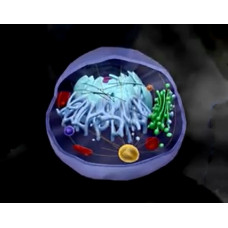From Ancient Greek πρῶτος, the first and ζῷα, plural forms from Ancient Greek ζῷον, a living being.
Protozoa is a subkingdom of animals. Eukaryotic organisms. Almost all Protozoa are microscopic in size. They have cell nucleus, mitochondria, chloroplasts, Golgi apparatus, basal bodies and cilia. They differ in the level of morphological and functional organization. Reproduction is both sexless and sexual. Many Protozoa are capable of incystation. Widespread. Free-living and parasitic forms. Some species (amoebae, infusoria, etc.) are widely used in scientific research. Marine Protozoa (radiolarians, foraminifera) played an important role in the formation of sedimentary rocks (globigerine, radiolarian mud).
Protozoa are usually about 5-45 micrometers in size, such forms are clearly visible in a light microscope. Some solitary and colonial species (large infusoria, radiolarians, etc.) can also reach several millimeters, they will be clearly visible to the naked eye. The smallest Protozoa (toxoplasmas and pyroplasmids) are 1-2 microns in size. Protozoa live in aquatic environments and soil and occupy different trophic levels. As predators they feed on unicellular or filamentous algae, microscopic fungi, other Protozoa species, and as microphages they feed on bacteria and detritus. Protozoa control bacterial populations and regulate their biomass. Can consume food by endocytosis - for example, amoebae surround food with pseudopodia and ingest it, while others have a cellular mouth (cytostome) through which they absorb food. Some Protozoa are capable of osmotrophic feeding.
All phagotrophic Protozoa digest food in compartments called vacuoles.[2] As components of the micro- and meiofauna, Protozoa are important food for microscopic invertebrates as well as fish fry. The ecological role is to transport bacterial and algal production to the next trophic levels. Protozoa include plasmodia, trypanosomes, leishmania and other parasites that are causative agents of dangerous human and animal diseases, as well as symbionts of multicellular animals. The flagellates - symbionts of termites and infusoria - symbionts of ruminants, which help their hosts to digest cellulose, play an extremely important role in the organic cycle. Protozoa reproduce by fission into two parts or by multiple fission. Some Protozoa reproduce sexually, some asexually, most groups reproduce both. In some species (e.g., malaria plasmodium), male gametes (microgametes) are formed from some cells and female gametes (macrogametes) from others. Another name for the taxon Protozoa is Acrita.
The food is very diverse. Some feed on tiny organisms, such as bacteria, others on unicellular algae, some are predators, devouring other Protozoa, and so on. Undigested food remains are ejected outside - in sarcodonts on any part of the body, in infusoria through a special hole in the pellicle.
Freshwater and some marine Protozoa have a special organoid associated with the regulation of osmotic pressure in the protozoan cell and with secretion. It is a contractile vacuole. It is a periodically appearing bubble in the cytoplasm, filled with liquid and emptied outward. The contractile vacuole regulates the amount of water in the cytoplasm, coming from the environment due to the difference in osmotic pressure. In parasitic Protozoa and in many marine forms living in an environment with increased osmotic pressure, contractile vacuoles are absent.
Protozoa have no special respiratory organoids, they absorb oxygen and release carbon dioxide with the entire body surface.
Like all living things, Protozoa are irritable, i.e., they have the ability to respond in some way to factors acting from the outside. Protozoa react to mechanical, chemical, thermal, light, electrical and other stimuli. Protozoa reactions to external stimuli are often expressed in a change of direction and are called cabs. Cabs can be positive, if the movement is in the direction of the stimulus, and negative, if it is in the opposite direction.
Protozoa, like all organisms, are characterized by reproduction. There are two main forms of reproduction: sexless and sexual. Both are based on the process of cell division. In sexless reproduction, the number of individuals increases as a result of division. For example, an amoeba in sexless reproduction divides into two amoebae by rearrangement of the body. This process starts from the nucleus and then takes over the cytoplasm. Sometimes sexless reproduction acquires the character of multiple division. In this case, the nucleus is pre-divided several times and Protozoa becomes multinucleated. Following this, the cytoplasm splits into a number of compartments corresponding to the number of nuclei. As a result, the protozoan organism immediately gives rise to a significant number of small individuals. Thus occurs, for example, sexless reproduction of malarial plasmodium - the causative agent of human malaria.
Sexual reproduction Protozoa is characterized by the fact that the actual reproduction (increase in the number of individuals) is preceded by the sexual process, the characteristic feature of which is the fusion of two sex cells (gametes) or two sex nuclei, leading to the formation of a single cell - zygote, giving rise to a new generation. The forms of sexual process and sexual reproduction in Protozoa are highly diverse. The main forms of it will be considered in the study of individual classes. Many species of Protozoa have not one, but several forms of reproduction, which can naturally alternate with each other. As a result, a complex developmental cycle is obtained, the individual stages of which can occur in different environmental conditions. The developmental cycles of parasitic protozoa in the class of sporozoa are particularly complex.
Protozoa live in a wide variety of environmental conditions. Most of them are aquatic organisms widely distributed in both fresh and marine waters. Many species live in the benthic layers and are part of the benthos. Of great interest is the adaptation of protozoa to life in the thickness of sand, in the water column (plankton).
Protozoa
Tags: protozoa





